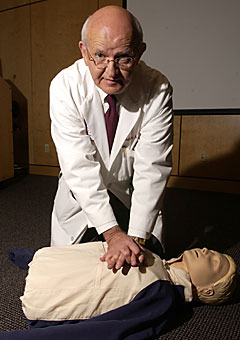 |
|
CHRIS CODUTO/Arizona Daily Wildcat
|
Dr. Gordon Ewy demonstrates where a person needs to place their hands to perform his new CPR technique. Ewy's technique requires 100 compressions a minute to keep blood flowing to the brain. His technique is already being used by the Tucson Fire Department.
|
|
|
By Zach Colick
Arizona Daily Wildcat
Wednesday, May 4, 2005
Print this
A UA doctor has said the way the Red Cross and American Heart Association teach the public about how to perform cardiopulmonary resuscitation is wrong and a newer method can help a patient's survival.
Each year, 600,000 people die in the United States because their heart suddenly stops beating and professional help does not arrive in time, according to a press release.
For more than 40 years, the Red Cross and the AHA have been teaching citizens to perform CPR with a combination of 15 chest compressions followed by two breaths in the mouth, according to a press release.
But Dr. Gordon Ewy, director of the UA's Sarver Heart Center, said most people who fall into cardiac arrest outside of a hospital don't survive because the big problem with CPR as it's currently practiced is the public fear to breathe into a stranger's mouth.
He said without the breaths to the mouth and immediately calling 911, blood can stop flowing to the brain, which makes chest compressions worthless when resuscitating a patient.
Ewy said continuous chest compressions - 100 times a minute - with no breaths is the right way to perform CPR and said without the public willingly ready to perform mouth to mouth, the Red Cross and AHA's method does not work.
So far, the Red Cross and AHA are staying with the old method only because they have to follow national protocol, said Laura Kitt-Hiiley, director of health and safety services for the American Red Cross Southern Arizona chapter.
Kitt-Hiiley said while the Red Cross may some day support the Sarver Heart Center's new method and research to help save lives, it must follow the emergency Cardiac Care Guidelines that are evaluated and updated every five years.
She said the current guidelines are from 2000 and since Ewy's method was just introduced, the Red Cross won't be able to look at the Sarver Heart Center's new methodology until the guidelines are reviewed again in December.
"The jury is still out on this matter, but we will move in whatever direction to help save lives," Kitt-Hiiley said. "The CCG will make recommendations on how to proceed."
If the public decides to perform mouth-to-mouth, Ewy said two breaths into the patient's mouth lasting for 16 seconds, instead of the perceived two breaths for four seconds is the correct way of performing CPR.
"It's essential that CPR is performed right away," Ewy said. "If you don't do anything for five minutes, they're dead."
Ewy said he has convinced the City of Tucson to start teaching classes with his new method. He not only persuaded the public, but also convinced the fire department and the paramedics that his method was the right way to perform CPR.
"We've been doing this for several months and we've received an enthusiastic response about it," Ewy said. "They're seeing better results and are encouraged by it."
Though Ewy's methodology might be a vast improvement, Kitt-Hiiley said she stands by the Red Cross' nationally recognized certifiable CPR courses. She said the Red Cross offers classes every week for students to learn how to perform CPR instruction on campus.
